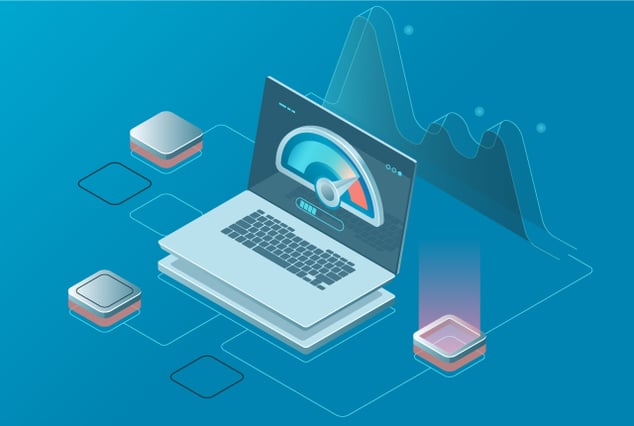
Nowadays, eCommerce applications are designed in such a way that customers can easily make purchases at any time of the day, irrespective of where they are located. If an eCommerce application malfunctions during peak hours, not only will it cause customer dissatisfaction, but it will also lead to revenue loss for the business.
To avoid such situations, companies can invest in performance testing of eCommerce applications that focuses on issues related to speed, stability, and scalability. Hence, in the wake of increasing demand for online shopping, it is necessary to do performance testing of the eCommerce application and to ensure that the application is stable and scalable enough to serve all customer requirements.
Goals of eCommerce Performance Testing
Performance testing is carried out on eCommerce software to ensure that the platform is functioning as expected. Let's explore why eCommerce application performance testing is important and how it affects the app's overall quality:
- Reduce Risks: Many times, making major and considerable changes to a site can cause notable strategic changes or even trigger significant losses. However, testing these changes in a planned manner can help eliminate the chances of these uncertain revenue losses.
- Increase Conversion Rates: By testing every aspect of an application and ensuring a smooth visitor experience through site optimization, the application conversion rate is bound to increase.
- Improve User Engagement: Testing tells which page element or process affects a user’s onsite journey and helps in rectifying the issues faster. The better the user experience, the greater the onsite engagement.
Benefits of eCommerce Application Performance Testing
Performance testing, when done effectively and consistently, can greatly boost conversions while also enhancing the overall experience of site users. The following reasons explain the significance of testing and optimization:
- Coupon codes or gift vouchers are provided to increase product sales and performance tests ensure that coupon codes work well when applied to users in bulk.
- Multiple systems like email servers, social network sites, and enterprise content management systems are involved in the backend and the performance test ensures flawless functioning of various features like product images/videos, and social media in such an integrated system.
- eCommerce applications usually have more users than any other application and validation of users is a must to filter out genuine customers. Performance test helps in validating multiple sign-up and invoice email notifications in parallel.
- Augmented Reality (AR) is an advanced-level feature provided by modern eCommerce websites so that customers can feel better without seeing products in person. With augmented reality performance testing, we can make the feature more efficient and pleasing to the eye.
- A recommendation system is a program that generates online recommendations using several algorithms, artificial intelligence, and data analysis. A well-designed recommendation system helps in better customer acquisition and retention. It is developed for both new and existing customers with different behavior for different customer types. Performance testing helps in making the recommendation system a faster system, to retain online shoppers.
- Chatbots interact with online shoppers to improve the user experience, and any delay in providing the required information may switch users to a competitor's application. Performance tests speed up chatbots to answer customer queries.
- Reviews are very important to increase the sale of a product. The majority of users prefer visiting the review listing page to get instant user feedback. Performance test helps in optimizing customer review listing load time.
- eCommerce applications attract the maximum number of customers during annual sales events. Backend servers should be set with the optimal settings, keeping future users’ traffic in mind. Performance tests help in identifying the servers’ optimum locations to manage a higher number of users.
Common Performance Testing Issues
Some common challenges faced in implementing performance testing are as follows:
- Slow DB server: Database size increases with the increase in product items of all ages, so ensure to optimize DB queries.
- Faster Integrated Systems Communication: Multiple systems like email servers, social media accounts, and payment channels are involved in the functioning of an eCommerce application to ensure that integrated systems work well under a heavy load.
- System Scaling: Brands cannot predict user load during peak hours, hence, the need of the hour is to be ready with tested scalable systems.
- Immoderate Scripts: Few eCommerce applications are associated with third-party scripts that are running in the background like Google Analytics and Ads, and these widgets can be a significant contributor to page load time.
- Slow Servers: Server resources and applications should be optimized to deliver content as quickly as possible after addressing any content-related performance issues.
- Massive Media: Oftentimes, images, videos, and other media are uploaded by non-technical employees that aren't familiar with the impact of loaded heavy files. It's important to ensure these assets are optimized to maximize performance.
Main Features to be Tested in eCommerce Applications
Your eCommerce website's success depends on choosing the features to test to ensure that it performs flawlessly. Some of the major features that require testing are as follows:
- Searching For a Product: eCommerce sites provide various search filters to make the search experience faster, which include price range, product type, country, and age. Hence, ensure that searching for a product among billions of records does not halt the system and return the expected records.
- Virtual Reality: Modern eCommerce sites provide advanced-level features to visualize products. Online shoppers can now see how they would look wearing an item virtually. Hence, we need to ensure the smooth movement of virtual images for a better experience.
- Testing Payment Gateway Integration: Failed transactions are one of the main reasons why most customers exit an application without completing the purchase. So it's important to ensure the proper functioning of payment gateways.
- Product Details Page: A fast product listing is important because every consumer will be attracted to the product by how it's presented and how it's visible to them.
Best Practices for Performance Testing
Mentioned below are some of the best practices for testing eCommerce applications:
- Test all CDNs (content delivery networks) by repeating time-bound hot transactions multiple times.
- Performance testing of big data plays an important role to ensure faster decompression and compression cycles to speed up the application’s speed.
- Online shopping has opened doors worldwide for businesses. Vendors shifted their servers to the cloud for better user coverage. Hence, tests from various geo-locations need to be performed to identify latency issues and to ensure that the geographical location of a user does not affect the speed of the application.
- Test individual servers before integration system testing to find bottlenecks like email servers, social accounts, DB servers, and enterprise content management systems.
- Volume testing plays a crucial role in seeing how storage systems function with or without a heavy load, hence including it in the test scope is a good practice.
Role of QASource
Testing experts at QASource have years of experience in running performance tests on a wide range of domains including eCommerce, media streaming, legal, human resources, eLearning, healthcare, enterprise content management, financial, and many more. QASource assists teams in setting up the performance test lab and identifying the best-fit performance test scenarios to ensure the best user experience. Following are our high-level performance testing services to meet the performance test requirement:
- Performance test plan
- Test data setup
- Simulation of test cases
- Generate performance test suite results
- Identify bottlenecks and follow up with the Dev team to fix them
- Generate daily status reports
Conclusion
Performance testing of eCommerce applications is a crucial part of any business's success. It helps eCommerce applications generate better user experience, safeguard user data security, and ensure mobile responsiveness, security, and a quick load time. It is vital to conduct quick and effective application performance testing from time to time to ensure that the application is offering an exceptional customer experience to maximize revenue for businesses. To learn more about our services, contact us today!

